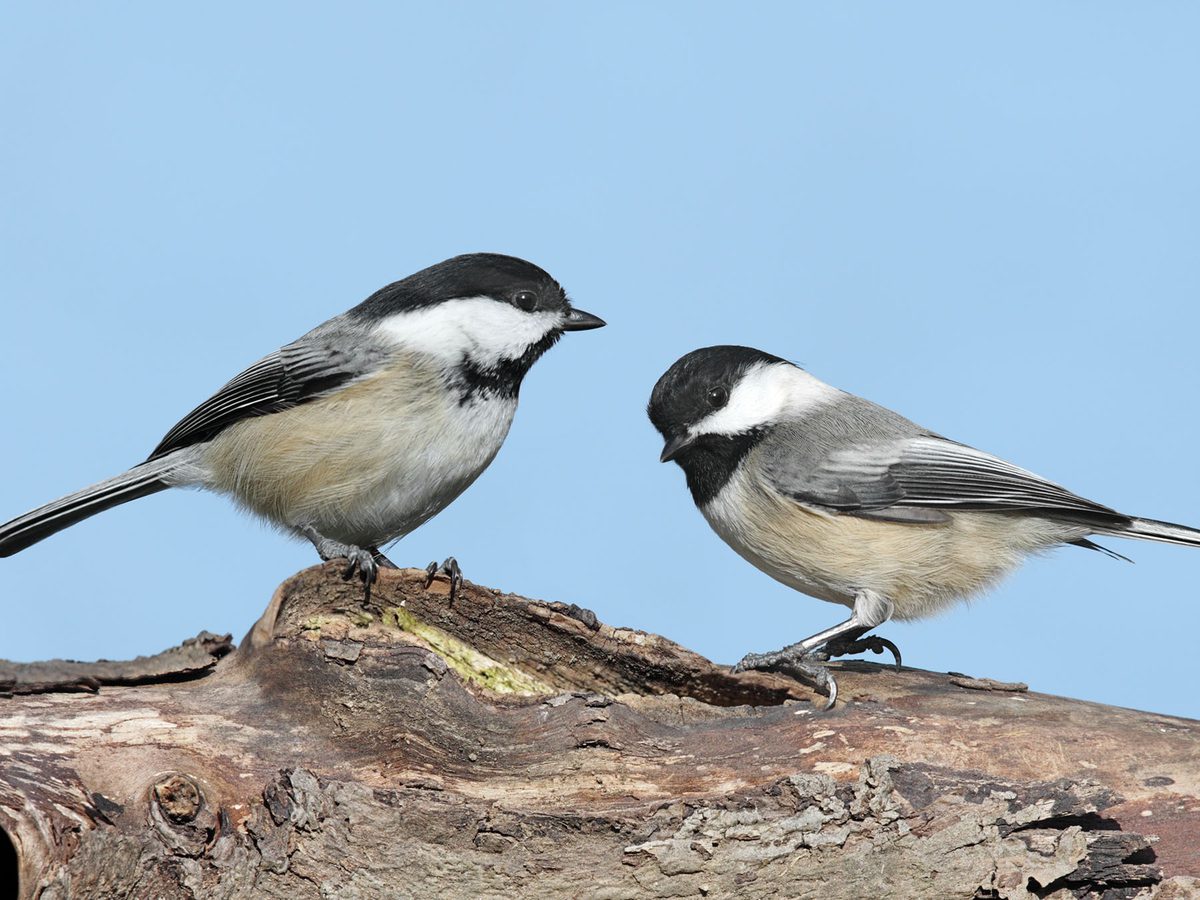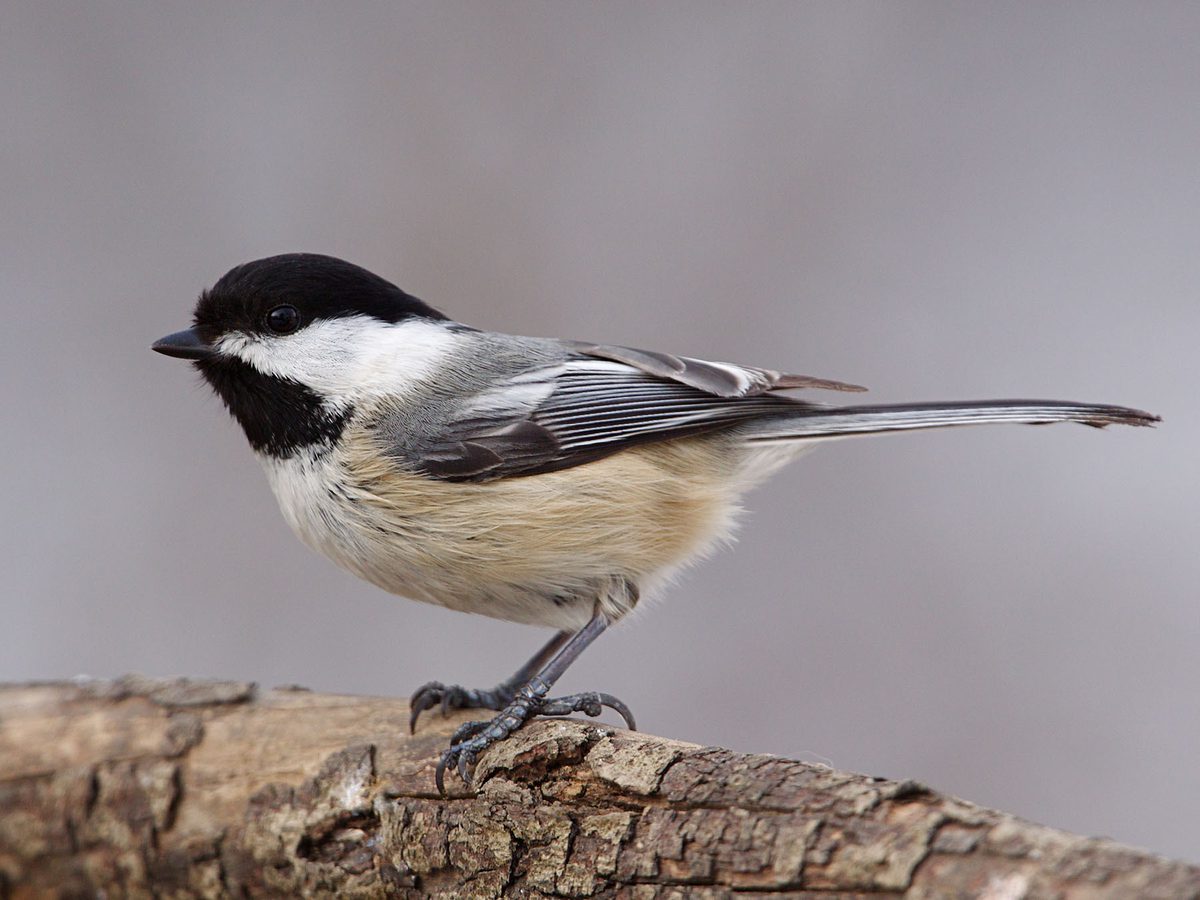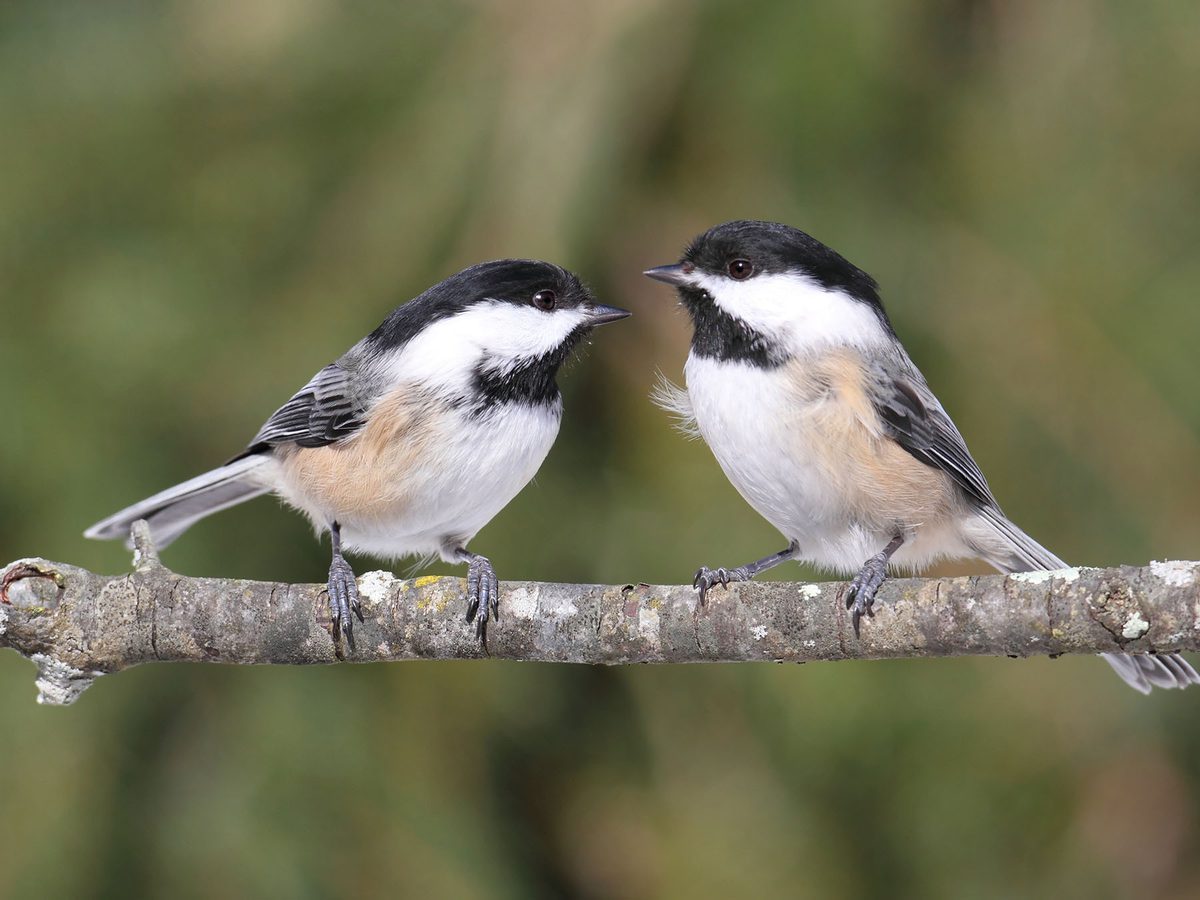You might be familiar with these tiny acrobatic black-bibbed songbirds, hopping and twisting through the branches of conifers in forests, parks, and even backyards. But how can we distinguish between male and female black-capped chickadees?
Our guide to female black-capped chickadees explores differences in appearance, behavior and nesting, so read on if you’re interested in finding out more.
Female black-capped chickadees share the same black-capped, black-bibbed plumage as the males. It is impossible to tell sexes apart visually, so behavior needs to be observed, particularly courtship rituals and nesting roles, before an accurate identification can be made.
Some research suggests that males may be slightly larger than females, or that the distinctive black bib marking of a male black-capped chickadee may be bigger than that of a female, but this research is inconclusive.
Most sources agree that the only way to tell males and females apart is to study their behavior and interactions with other birds of the same species. Nesting and courtship are two particular areas, although our guide will be looking at calls and vocalizations too.
If you’d like to master the art of successfully telling male and female black-capped chickadees apart, then our guide will help you do just that!

There is no visual way to tell the difference between male and female Black-capped Chickadees
How can you tell if a Black-capped Chickadee is male or female?
There is no visual difference in plumage or size between male and female black-capped chickadees, so in order to tell the sex of a bird of this species, we need to rely on observations of behavior and activity, such as songs and calling, and role in nest-building and raising young.
What does a female Black-capped Chickadee look like?
Female black-capped chickadees are small and agile, with black, gray, white, and buff coloring. As their name suggests, they have a black capped head, and this is matched with a black bib under the bill, which is short and dark.
Their wings are rounded, and relatively short in proportion to their tail and body.
The sides of a female black-capped chickadee’s face are white, and her back and wings are light greenish-gray, with a darker, slate-gray tail. Underparts are a whitish-buff shade, with rusty-brown flanks.

A breeding pair of Black-capped Chickadees - note the exact same plumage
Are female Black-capped Chickadees bigger than males?
There is some suggestion that male black-capped chickadees are slightly bigger than females, although not enough evidence exists to conclusively state this is true for all birds of the species.
Typical measurements for the species are a body length of 12 to 15 cm (4.7 to 5.9 in), a wingspan of 16 to 21 cm (6.3 to 8.3 in), and a body mass in the range of 9 to 14 g (0.32 to 0.49 oz).

Close up of a Black-capped Chickadee perched on a log
Behavior differences
As there are no clear visual differences between male and female black-capped chickadees, observing their behavior is usually the only conclusive way of deciphering what sex they are.
Black-capped chickadees are social birds, forming flocks outside of the breeding season, which fall into a hierarchical ranking of dominant to less-dominant birds. Females tend to be attracted to stronger males, as their social standing will allow females better access to food supplies and larger territories.
During courtship, females will be pursued in flight by interested males. Pairs form early in the winter season, long before the breeding season begins, with females choosing a mate that will offer them protection from other males and females at feeding sites.
This, in turn, ensures the female is in top condition for producing a healthy brood when the breeding season eventually begins.
Hierarchy within a mated pair is apparent too, with the male bird asserting himself into a dominant position ahead of his mate, seen with the male feeding first while the female waits her turn.
According to observations, female black-capped chickadees are not as aggressive as males. Females do fight and will contest any intrusion to their territory, but are generally more timid.

Male and female Black-capped Chickadees perched on a branch
Singing and calls
One particular call of black-capped chickadees is made almost exclusively by males: known as the fee-bee call, or “hey sweetie” song, this two- or three-note whistling call is primarily used by males to attract a mate.
A softer, lower-pitched version may be exchanged between mates when feeding at the nest site.
During the breeding season, females can be heard making a distinctive rasping call immediately before they begin laying eggs.
When their nest site is threatened, females make a loud hissing cry, sometimes known as a ‘snake display’ from inside the nest when defending young chicks.
The noisy, harsh sound mimics the hiss of a snake, and aims to deter predators from entering the nest cavity.

Perched Black-capped Chickadee singing during the spring
Nesting and feeding
During courtship, the female noisily begs for food, and is brought grubs and other insects by the male. Such displays of being a strong provider assure the female that the male will make a good mate.
Nest site selection is thought to be led by the female, although once a tree has been identified, both the male and female work together to excavate the nest cavity in a soft or decaying tree trunk. The pair hollow out a chamber, with both birds involved in the intricate work of removing wood chippings away from the site until a big enough cavity has been made.
Once a hollow has been completed, the female takes over with preparing the internal chamber, constructing a nest from bark and moss, with a rounded, softer cup of grass, animal fur and feathers on top, in which the eggs are laid.
Incubation is the sole job of the female black-capped chickadee, who is brought food on the nest by her mate for the duration of her incubating and subsequent brooding duties.
Once the chicks are around 8 days old, females begin to spend longer periods away from the nest, foraging for themselves and their young.
By around 16 days, young are ready to fledge and are supported outside the nest by both parents who continue to bring food for another week or so.

Both male and female chickadees work together to excavate the nest cavity
Can female Black-capped Chickadees raise young alone?
Although female black-capped chickadees are the sole incubators of eggs during the nesting period, they rely on the male to bring them – and later their young – food.
Due to this division of responsibilities, it is unlikely that a female would be able to successfully hatch eggs and raise young alone, due to the time away from the young dependent hatchlings if she also needed to forage for food to bring back to the nest.
What color are female Black-capped Chickadees?
Female black-capped chickadees have black heads and bibs and white cheeks. Their backs are a light greenish-gray, which darkens towards their tails into more of a charcoal-slate gray shade. Their underparts are a whitish-buff color, and their flanks are marked with small patches of rusty-brown feathers.

Black-capped Chickadee taking a break before eating the sunflower seed
Do female Black-capped Chickadees call?
Females do not make the same loud ‘fee-bee’ call associated with territorial male black-capped chickadees. Still, a similar, quieter call may be made by nesting females near the nest site, especially when food is brought by the male. Females also make a rasping call ahead of laying eggs.
Do female Black-capped Chickadees sing?
Female black-capped chickadees can frequently be heard singing the ‘chick-a-dee’ song from which they take their name, particularly in fall and winter.
The song, sung by both males and females of the species, is a multi-purpose song, used to communicate danger, a threat subsiding, an alert to a new food source, or call when separated from a flock.
